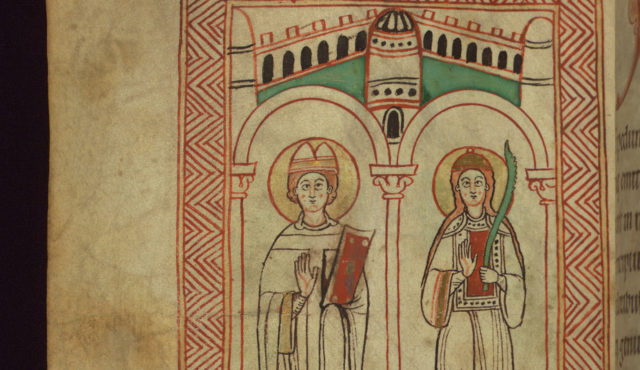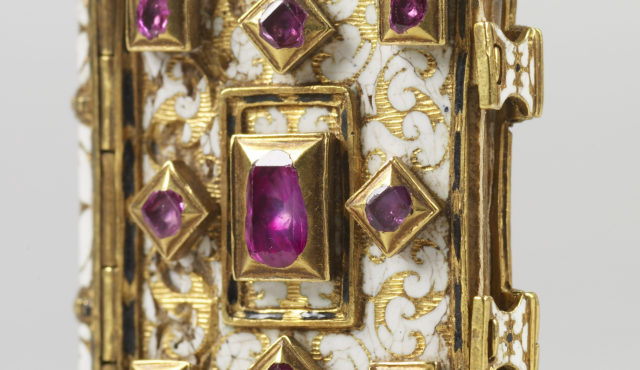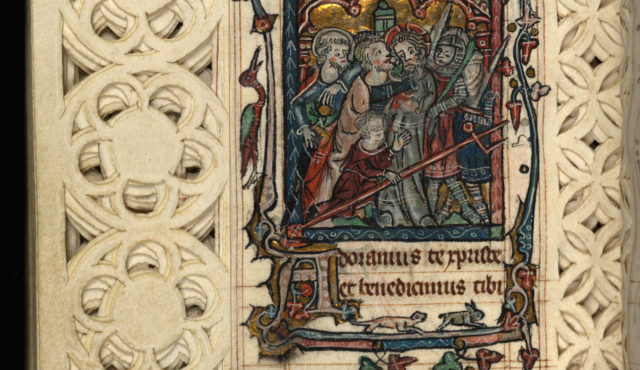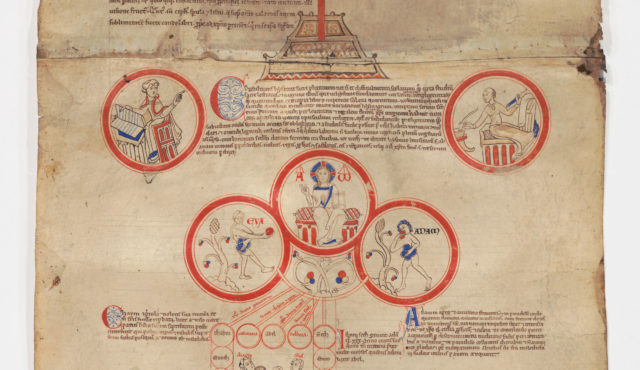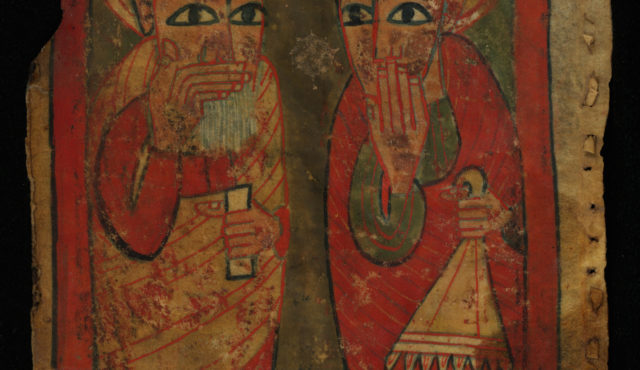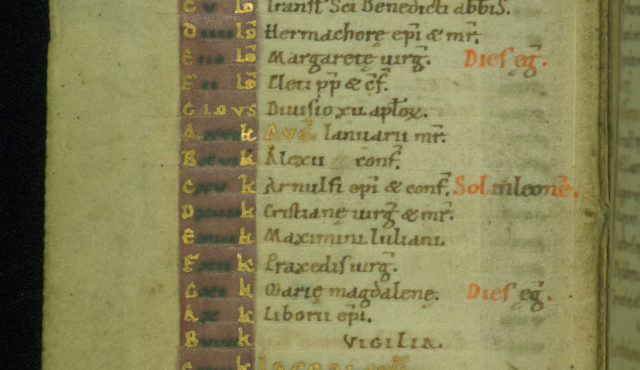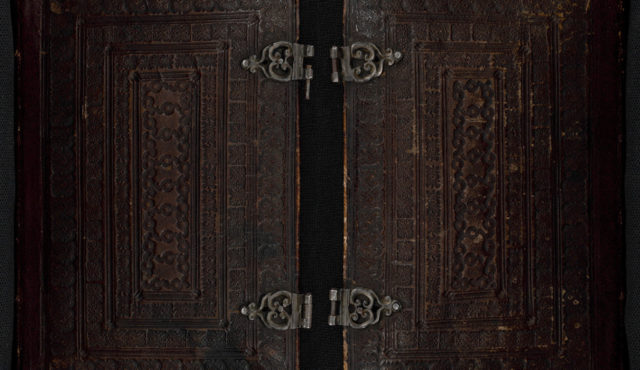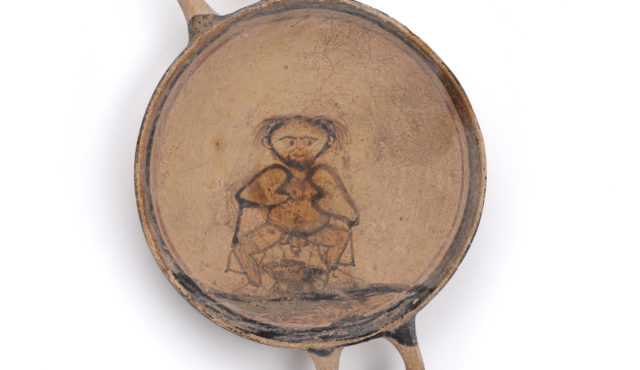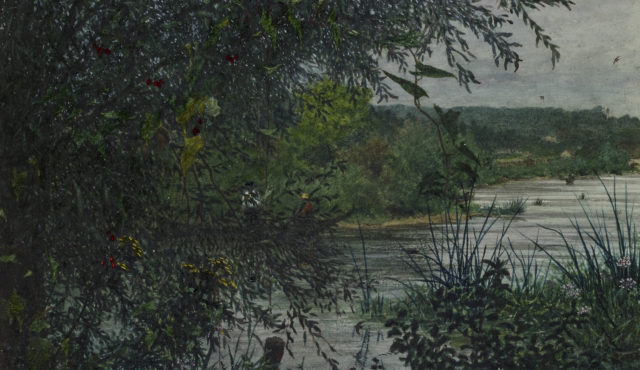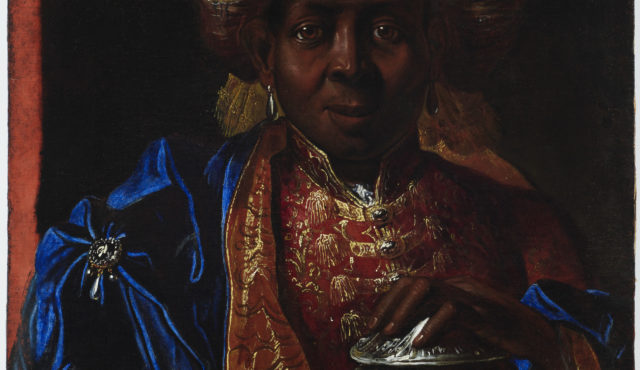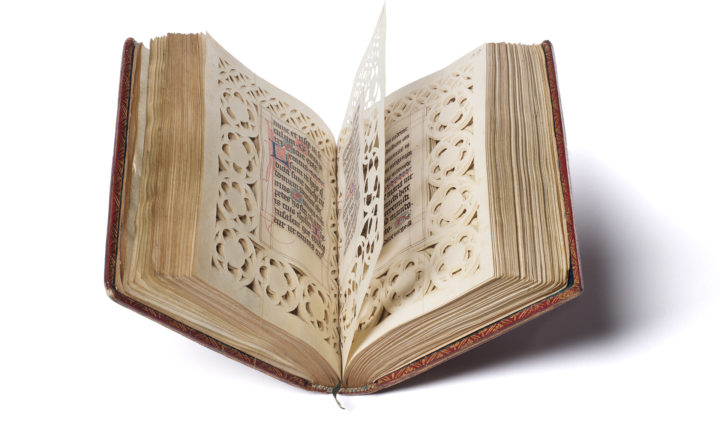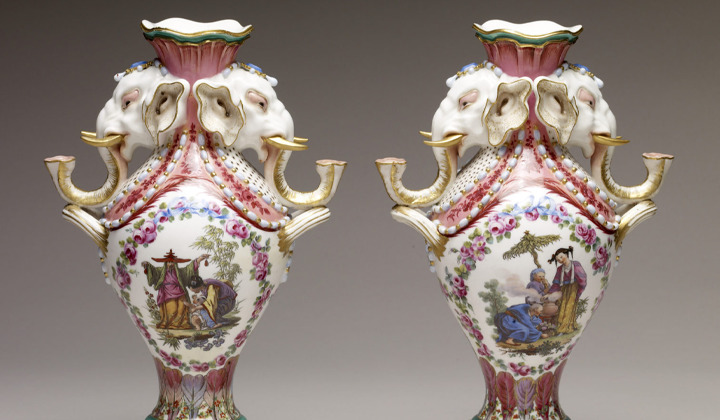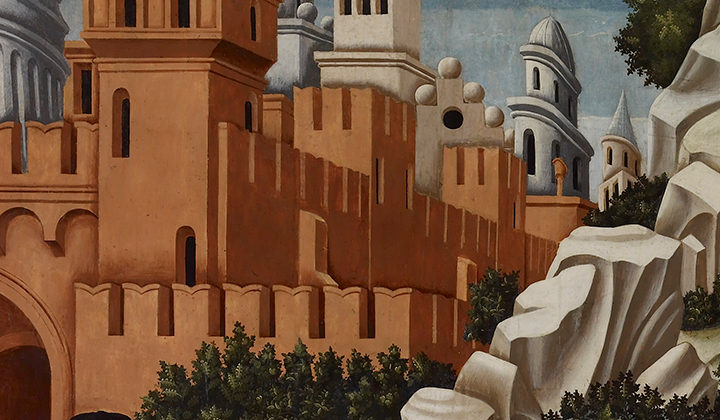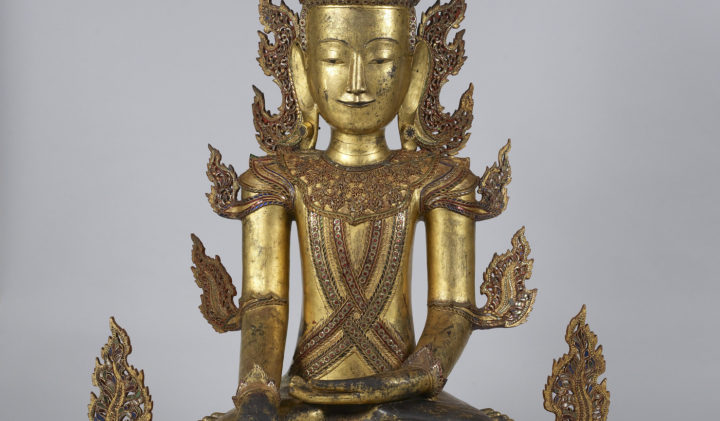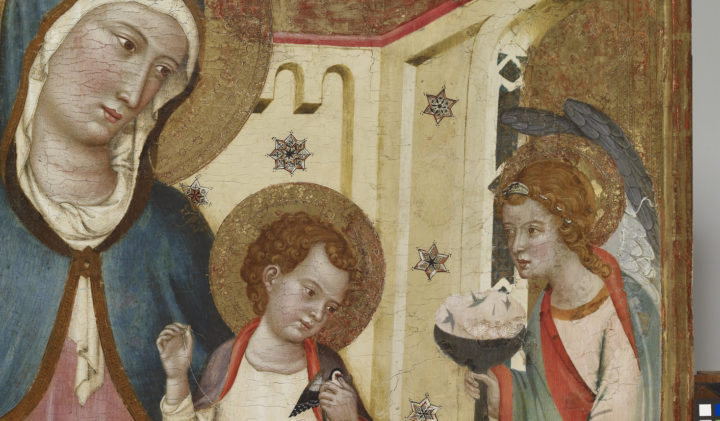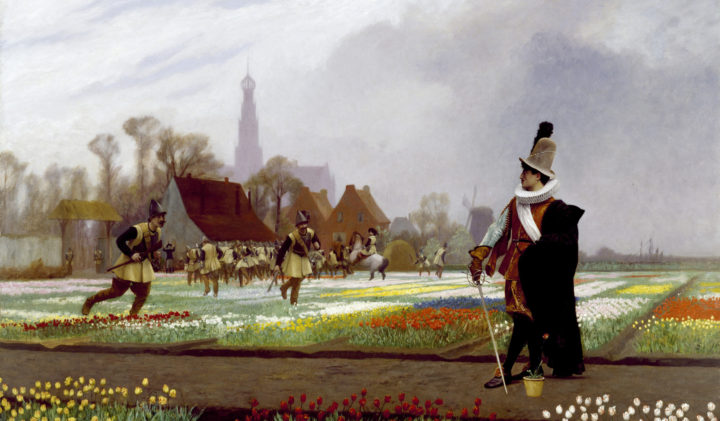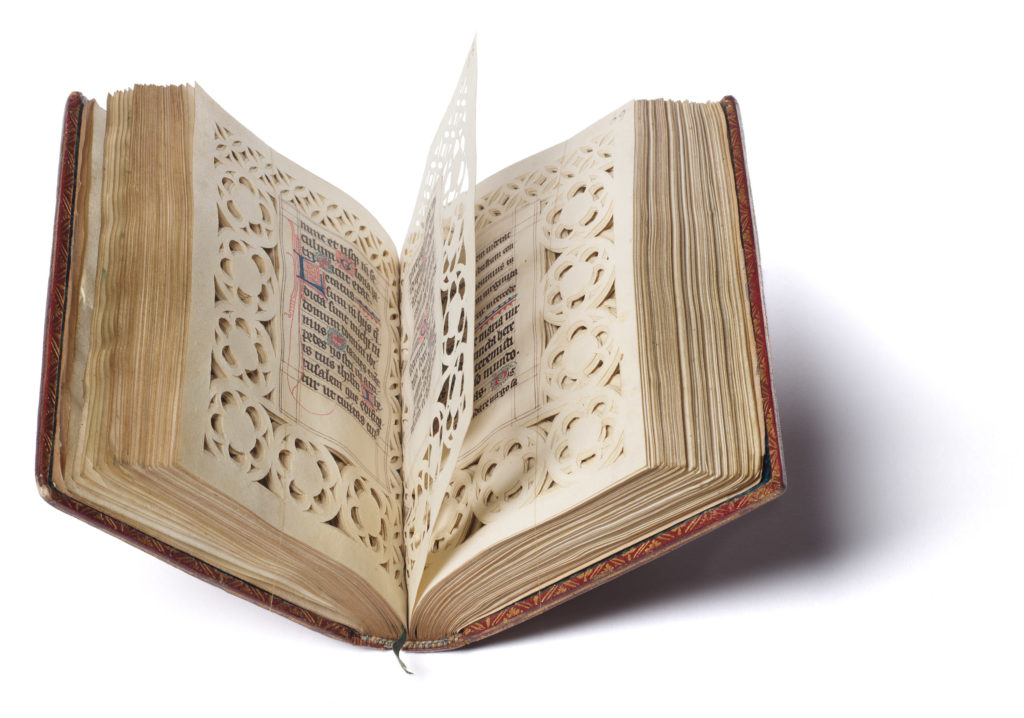
Unknown French artists, Opening with “lace” borders, De Bar Hours, Northeast France (Lorraine), ca. 1310, ink and pigment on parchment. The Walters Art Museum, Baltimore, acquired by Henry Walters, by 1931, acc. no. W.93
The de Bar Hours is a book with an extraordinary secret. Sitting quietly on a shelf in the Walters rare book library and bearing the innocuous number W.93, this early fourteenth-century French manuscript blends in with over 200 other Books of Hours collected by the museum’s founder, Henry Walters.[1] Its eighteenth-century binding is understated and unexceptional, and only the book’s atypically squarish proportions suggest something unusual is afoot. Opening the book unfailingly brings gasps of surprise and delight from unsuspecting visitors, and even seasoned manuscript scholars find themselves completely unprepared for the exceptionally beautiful and unique effect of its pages (fig. 1). Each cut creating the same delicate pattern of rosettes, its parchment margins are captivating for their strangeness… Are they elegant, or “crafty?” Are they meant to appear fragile like lace, or solid, like carved stone? The unique and special quality of this manuscript is not only nearly impossible to put into words, but also surprisingly difficult to capture in images. It is the kind of object where modern book digitization enters new territory and must meet new challenges. Unlocking the wonder of this book relies on experiencing it as a complete object, which images of individual folios actually hinder. This essay, with the accompanying digital components, attempts to understand, capture, and share the special magic of a book unlike any other.
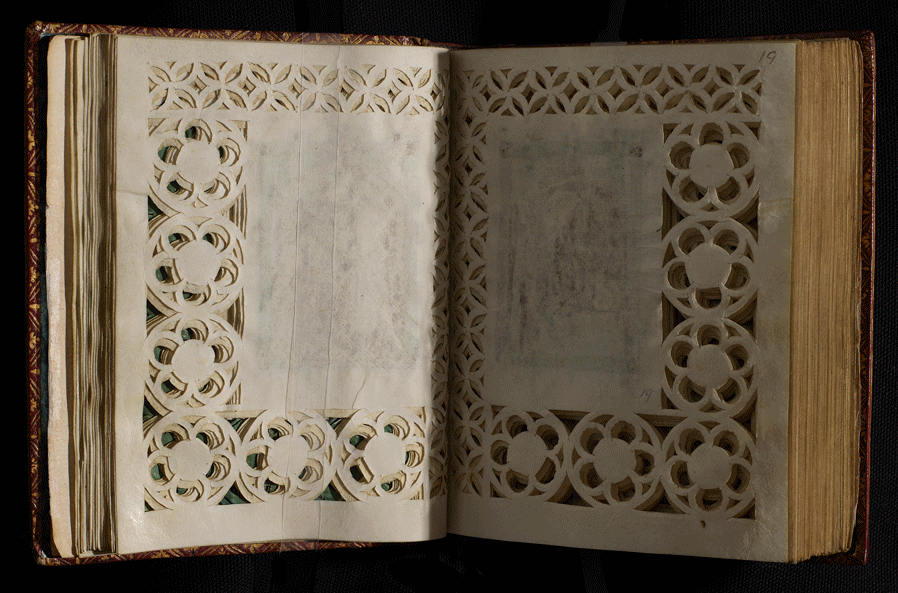
GIF showing turning pages, De Bar Hours, acc. no. W.93
Upon first glance, the manuscript’s cut borders look delicate and incredibly fragile, as if they might break apart at any moment, and this expectation instills a sense that extra care must be taken when handling them. Although in reality they are surprisingly strong due to the durability of the parchment they are made from, their perceived fragility significantly affects how one turns the pages, encouraging the reader to slow down and to go through the book in a more deliberate, focused way (fig. 2). Yet while individual leaves look like lace, the repetitive visual layering of those pages also creates a striking sense of solidity that brings to mind deeply carved gothic stonework,[2] which allows the user the strange and wondrous experience of seeing through the book. There is a sense of light and shadow that is ever shifting as the book moves and the pages turn, an effect which would surely only be amplified in flickering candlelight or dappled sun.
It is not only this extraordinary visual experience that makes the manuscript exceptional, however; it also feels like no other book. There is a sensuous quality to the pages as you touch your own skin through the velvety parchment when holding it between your fingers, which peek through and almost meld with the page as skin meets skin. The texture of the cut patterns also encourages a tactility not usually experienced when handling the leaves of books which, from personal experience, leads to an unconscious instinct to run your fingers along the openings while gazing at the text. It feels oddly meditative, not unlike the way one might count rosary beads. Through light, shadow, and texture, the entire book engages the senses in unique and unexpected ways that can only be fully experienced through handling the physical object.
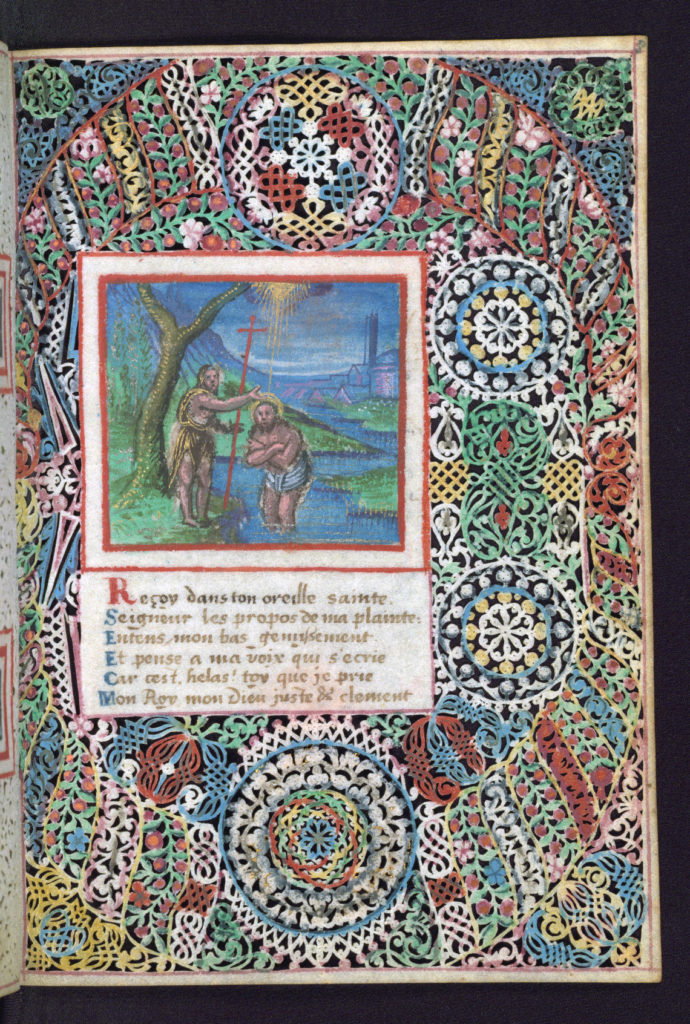
Unknown French artist, John the Baptist Baptizing Christ, Lace Book of Marie de’ Medici, ca. 1630, ink and paint on parchment. The Walters Art Museum, Baltimore, acquired by Henry Walters, by 1931, acc. no. W.494, fol. 8r
What other medieval manuscript behaves like this? It has a unique quality, even within the context of other “lace-cut” manuscripts. There are indeed others, and in fact, the Walters has a famous example that once belonged to Marie de’ Medici.[3] However the two books are wholly different in effect, with each margin of the Medici manuscript intricately cut to resemble different patterns of Venetian lace that are also often painted to call out the designs (fig. 3). This difference may be reflective of the fact that over three hundred years separate the projects, for the Medici book dates to the 1630s, while the de Bar Hours was created circa 1310.[4] But the lacuna here is more than just a gap in time; it is also a gap in surviving examples. The de Bar Hours sits alone in the early fourteenth century, with nothing even remotely comparable known until several centuries later.[5] For all intents and purposes, the de Bar Hours should not exist.
A Curatorial Conundrum
There is a strange disconnect between the highly traditional core of the book and its precariously porous edges. The text and illumination of the de Bar Hours unquestionably dates to circa 1310, a timeframe that can be firmly established based upon a myriad of factors such as script and artistic style.[6] The cutting of the margins, however, is so jarringly unexpected in the context of what is otherwise a fairly typical Book of Hours of this period that it has given generations of Walters curators pause. Is it original to the book’s production, and just remarkably unique? Or is it a case of blandly blank margins having been modified at the behest of a later collector or dealer in order to perhaps amplify the book’s value or beauty? Both possibilities have swirled around the manuscript over the past century, and this essay will endeavor to put this debate to rest at last.
Early notes in the museum’s thin file, which appear to be in the handwriting of the Walters’ first curator of rare books and manuscripts, Dorothy Miner (tenure: 1934–1973), speculate that the cutting may have been contemporary with the book’s production, and Miner’s early gallery labels note the lace margins as a curiosity.[7] However, there is no fuller reference to the cut margins, or an exploration of their significance if they were indeed original to the book. The only correspondence preserved in the file is, significantly, a two-sentence letter from Anthony R. A. Hobson, who was the head of the book department at Sotheby’s for a quarter of a century and truly one of the great book scholars of the twentieth century. His brief note, dated 1957, is a short response to an earlier letter he had received from Miner, in which she had apparently mentioned the de Bar manuscript while answering his inquiry about the Medici lace book.[8] Hobson’s surprise and wonder at the unexpected revelation comes through in his comment, “I certainly had no idea that you owned a lacework manuscript of about 1300 or that such a thing even existed.” Hobson had wide access to, and deep knowledge of, the rarest books and manuscripts, so his response is telling. Yet for all of the glimmers of curiosity in those early, tantalizing notes, there is no evidence of further investigation to determine if the cutting was actually original to the book.
The Walters’ second curator of manuscripts, Lilian Randall (tenure: 1974–1997), approached the manuscript with healthy skepticism, asking the logical and important question: if this is such a complete outlier, then does it stand to reason that the anachronistic cutting of the margins might have happened later?[9] In her remarkably comprehensive catalogs of the French manuscripts in the Walters collection, which remain foundational today, her entry for the de Bar Hours offers the first investigation into the manuscript that is both deep and thorough. Randall grappled with the presence of cut margins in a book so early, stating “At whose behest and at what date the lace-cut borders were added remains open to question.” Ultimately, she suggested that the cutting may have occurred in the eighteenth century, likely aligning it with the book’s rebinding at that time.[10]
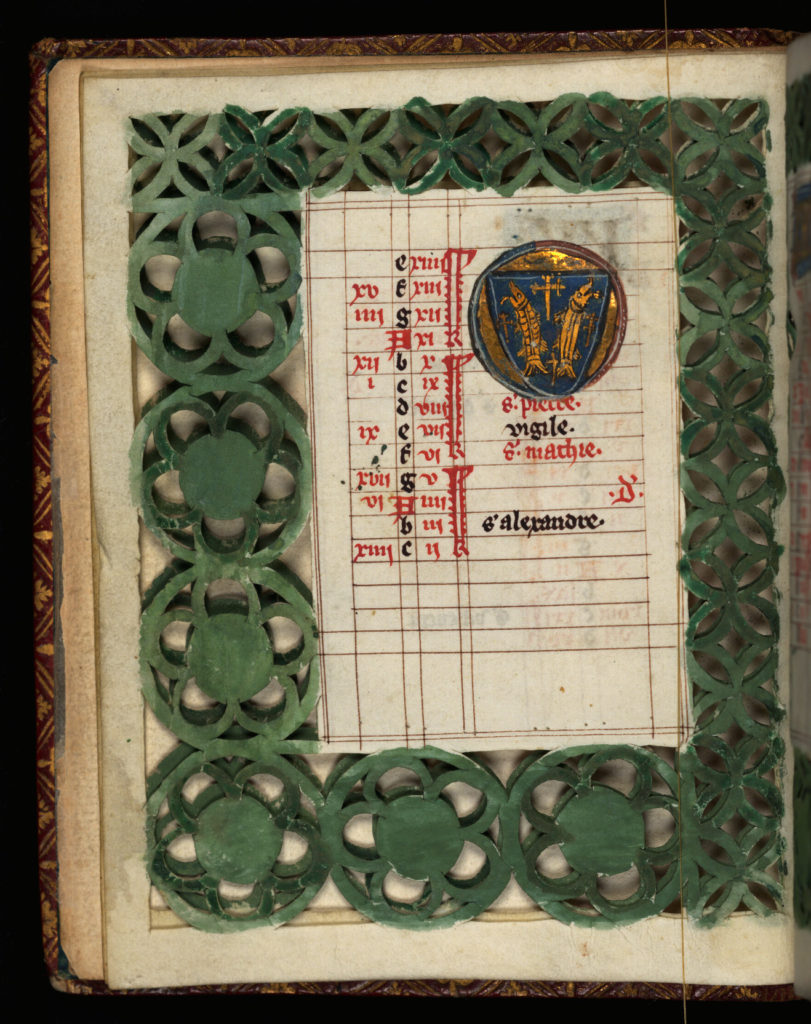
February calendar with heraldry and green borders, De Bar Hours, acc. no. W.93, fol. 2v
The suggestion that the cutting of the pages might have happened well after the initial manuscript was produced is logical for a number of reasons. The margins of the calendar, which are cut in the same pattern as the rest of the book, are actually painted an odd, slightly dingy green (fig. 4). This paint appears to be an attempt to touch up a lighter, earlier green paint that had worn away. The overpainting is sloppy, and was carried out while the book was in its current eighteenth-century binding, as is evident from an area where the paint splashed through an opening in the margin and hit the paper flyleaf behind it. The paint itself is problematic, for while the strange hue alone suggests a post-medieval date, a recent technical analysis by former Walters conservation scientist Glenn Gates revealed that this green pigment was created by mixing orpiment with Prussian Blue.[11] The presence of Prussian Blue firmly places the use of this paint in the eighteenth century at the earliest, as that pigment was not invented until 1706. Its presence suggests an attempt to update and “spruce up” the manuscript many centuries after its original production.
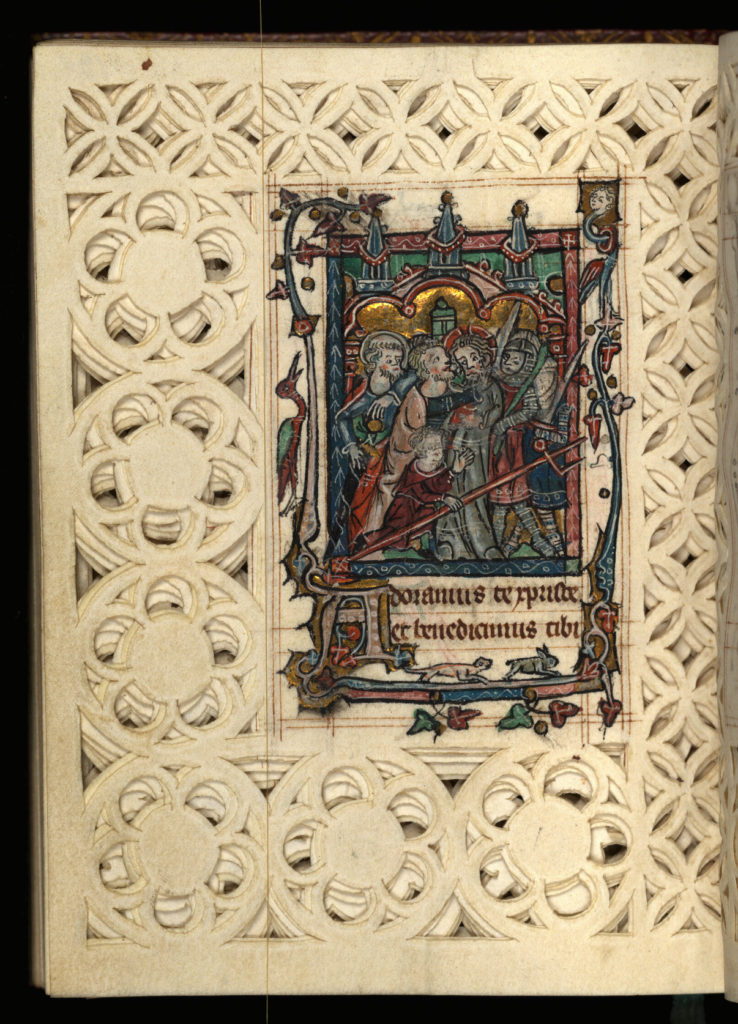
Misaligned cutting in “lace” borders, De Bar Hours, acc. no. W.93, fol. 130v
Turning to the cut rosettes in the margins themselves, these also appear not to have been carefully done. The edges of the cut openings are at times visibly ragged, and when layered, the patterns are often skewed rather than precisely aligned as would be expected if they had been planned from the outset (fig. 5). It was therefore a persuasive idea that perhaps not only the green paint but the cut patterns, too, were part of a later campaign to give an old book new flair. This explanation for the book’s odd appearance is far easier to accept than the alternative: that it is a complete anomaly. There is just no other known book like this from 1300. Or 1400. Or even 1500. Therefore much hinges on the question of whether or not the cutting is original.
Fresh Eyes
Ignorance can be bliss. When first encountering the manuscript as the newest curator of the collection in 2013, I was unaware there had been a debate around whether or not the book’s cutting was contemporary with the book’s initial creation, and my unfamiliarity with the tradition of lace-cut manuscripts meant I had no frame of reference for what was—or was not—the norm in 1310. To my eyes, the cutting appeared integral to the layout and overall planning of the book, but I did not register that this fact might be significant until I began tracing the questions and concerns detailed above. Delving into the manuscript’s file, I discovered that a scholar named Yael Hoz had left brief notes during her visit to the Walters in 2009, stating with confidence that the cut patterns in the parchment were unquestionably original.[12] As her encounter with the manuscript occurred two decades after the publication of Randall’s catalog, Hoz’s thoughts had yet to be taken into account. However, her certainty is significant in that it was born out of her highly specialized expertise as a scholar of the Jewish papercutting tradition.
Hoz’s research informed an important exhibition and accompanying publication that documented the long and complex tradition behind parchment and papercutting more broadly, as it is an art form found across the globe from China to the ancient Americas.[13] For those trained in book production, it was a small step from generally cutting leather or parchment to cutting designs into those materials, and Coptic bookmakers are known to have cut patterns into leather bindings as early as the ninth century.[14] That kind of cutting in binding manufacture made its way into Europe through Islamic craftsmen settling in Spain.[15] In cultures where scribes had a small pen knife constantly on hand to sharpen their writing quills, they already had the necessary tool to cut designs into parchment or paper—all it took was the thought to do it. The term often used to describe those cut designs, “canivet,” or literally “little knife,” is derived from the Old French word for the scribe’s pen knife, canif.[16] The cutting of manuscript borders can be found in many traditions, from Jewish marriage documents to holy cards created by Catholic nuns. This kind of cutting is typically referred to as a form of folk art. I have found suggestions that it is possible the craft goes back as far as the thirteenth century, but have yet to see any physical evidence offered to support that assumption, and the earliest examples of cut designs in manuscript codices I have seen all date from the 1600s.[17] There is a huge gap in our knowledge. The inference is that either no early examples survive, or else that they simply did not exist. What follows is evidence that there was at least one such early work created within this remarkable tradition, and its existence may help shed light on the history of this fascinating technique.
Close Looking
As with so many manuscript mysteries, much can be revealed through challenging our own assumptions and spending time practicing close looking—the kind you can only truly do with the actual object in front of you. With the invaluable partnership of Abigail Quandt, the Walters’ head of book and paper conservation, it was possible to conduct a careful investigation of the physical properties of the manuscript, and the de Bar Hours slowly began to spill its well-guarded secrets.
From the beginning, general codicological abnormalities indicated that this was not an ordinary manuscript production. The book is nearly square, at 10.8 x 12.5 centimeters (4 ¼ x 5 inches), which is an unusual proportion in comparison to the typically rectangular shape of manuscripts in this period. This square format is not, however, dictated by the layout of the text, which is ruled in rectangular panels, but rather by the way the marginal patterns shape the pages. While the upper margin and interior margin by the gutter are cut with narrow panels containing simple quatrefoils measuring 1 centimeter across, the outer and bottom margins are much wider, each containing a series of five-lobe rosettes within roundels measuring 2.3 centimeters, or nearly a full inch, across. Those slightly enlarged outer margins seem to have shifted the book’s proportions from the typical rectangular format toward nearly square, and that extra width— which would be unnecessarily large in a regular manuscript—is logical if it was designed to accommodate the five-lobe pattern while still leaving enough of a border of uncut parchment to allow for the pages to be safely grasped and turned.[18]
The book’s quire structure is also telling, for with the exception of the calendar, which is a quire of twelve, the entire book is composed of quires of four, instead of the far more standard eight. Close examination of the lace margins in those quires reveals that the individual knife marks match exactly across each group of four folios, demonstrating that they were cut together.[19] One can imagine that cutting through a stack of eight parchment leaves at one time would be nearly impossible due to the strength and thickness of the animal skins, so breaking the quires down into groups of four was far more manageable. The decision to produce the book in these unusually smaller gatherings had to be made in the initial design phase, which supports the possibility that the cutting of the margins was already intended when the parchment was being prepared. While it is not impossible that a later campaign of cutting would have taken advantage of wide margins and thin quires, the coincidence of both of these unusual features seems much more likely to be a product of the planning and not the reception of the codex.
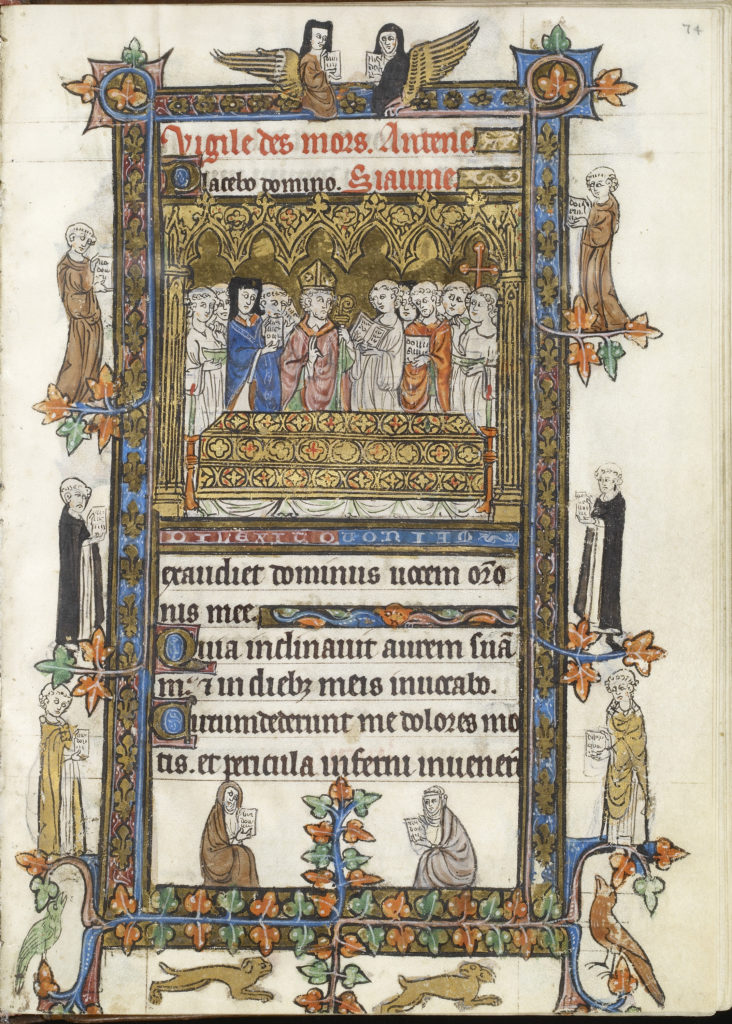
Flemish, Marginalia in Book of Hours, Northeast France, ca. 1300–1325, ink and pigments on parchment. The Walters Art Museum, Baltimore, acquired by Henry Walters, by 1931, acc. no. W.104, fol. 74r
The layout of the text and imagery further supports the contention that the lace margins were integral to the project from the start. All ruling lines and illuminations are strictly confined to the central, uncut panel, and nothing has been erased from the overly large, clean margins. Had they not been intended for this cutting, the margins would have appeared strangely wide and superfluous while the text and illumination were tightly squeezed into the center. In her catalog entry, Randall discusses drolleries in the “margins” around the images (see for example the dog chasing the rabbit in fig. 5),[20] but in fact these lively critters very carefully do not scamper into the margins as they normally do in other manuscripts (fig. 6).[21] It was this strange phenomenon that first convinced me that the images were designed with the cut margins in mind, but on its own, it was not strong enough evidence to be sure.[22] However, deeper investigation revealed a crucial clue that proves beyond a shadow of a doubt that the text and illumination were actually planned in tandem with the decision to cut the margins.
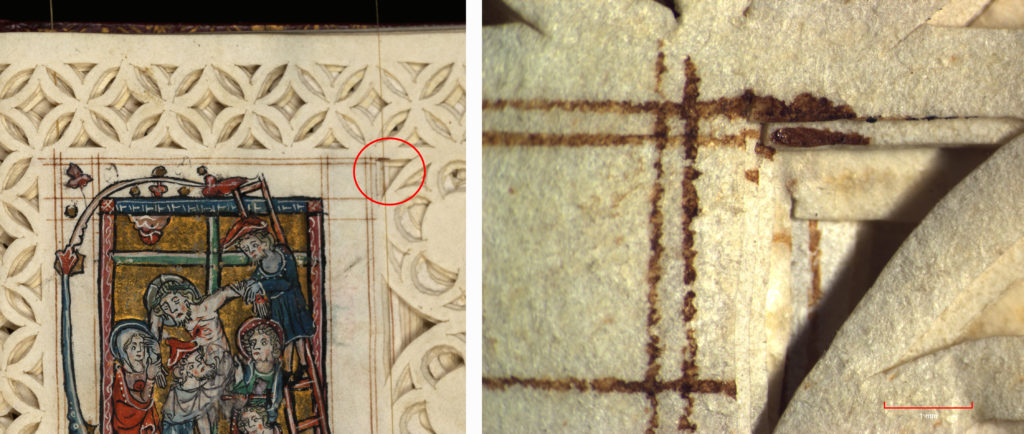
Pen slip through cut opening, with photomicrograph details, De Bar Hours, acc. no. W.93, fol. 139r
Logic dictates that if the cutting was original, it must have happened first. There is too much risk in cutting pages that had already been painstakingly written out and illuminated, as an accidental slip of the knife would ruin not one leaf, but four at once—disaster! It would also presumably have been easier to do the cutting if one could steady their hand against the parchment without the concern of smudging ink or paint. Therefore, assuming the holes were already there when the scribe and illuminator went to work, I looked for spots where they might have stumbled a bit when working with a page format they were unaccustomed to. Ultimately, it was the tiniest pen slip that blew the entire investigation wide open. In the upper corner of fol. 138r, it is possible to see the ink of the scribe’s ruling line fall through the cut design and leave a matching mark on fol. 139r, which must have been stacked underneath it while the pages were being ruled (fig. 7). In another instance, on fol. 30r‒v, a drop of red ink from the scribe’s pen dripped onto the margin and slipped through the opening on the page, soaking the inside of the cut with red, and leaving crimson smudges on the other side of the leaf (fig. 8). These are just a few of many examples that would simply not exist if the cutting was performed later in the manuscript’s history; the openings had to have already been there before the pages were even ruled. Therefore rather than being added long after the fact, the patterns must have been the very first steps of the book’s production.
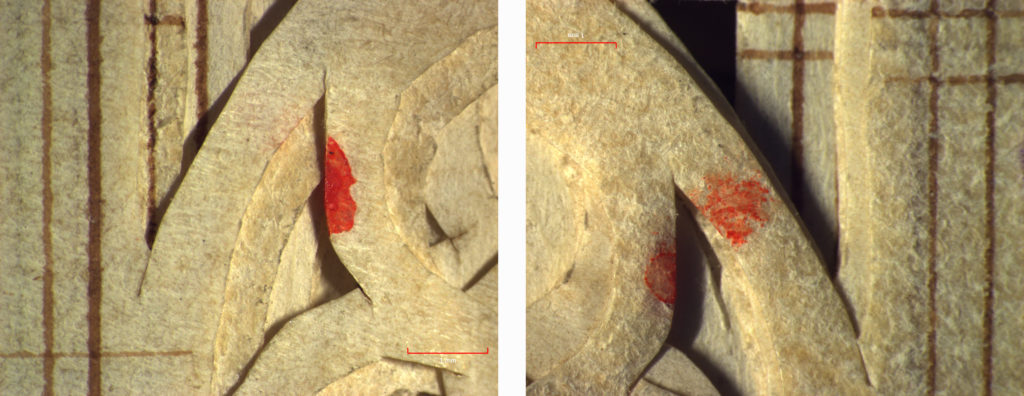
Red ink drip passing through cut opening on recto, and resulting ink smudge on verso, photomicrograph detail, De Bar Hours, acc. no. W.93, fol. 30r–v
The canivet itself must have been an extraordinary effort and possibly something unprecedented in terms of creating an entire book this way. There are occasional traces of a sketched design (visible for instance on fols. 63v and 140r), but overall it appears to have been done freehand, likely with the help of a stencil. Individual tiny cuts show the painstaking process, although noticeable variants in the accuracy of those incisions suggest that at least two different artisans created the patterns: one more tentative who made choppy cuts, and the other more confident, slicing the skin in smooth, clean strokes (fig. 9). Alternatively, the difference in the cutting could have been due to the use of different tools, or even the need to use a tool in another way if it became too dull to make large, clean slices. Guide prickings which Quandt suggests may have been made with a small tool such as an awl, are visible as slightly squared punctures, and likely helped the artists safely hit the endpoint of each cut so they did not risk slicing too far (fig. 10). However, there are still spots where the slip of the knife severed the parchment entirely and it had to be patched, allowing us to imagine how difficult it must have been to get this right every time (fig. 11).
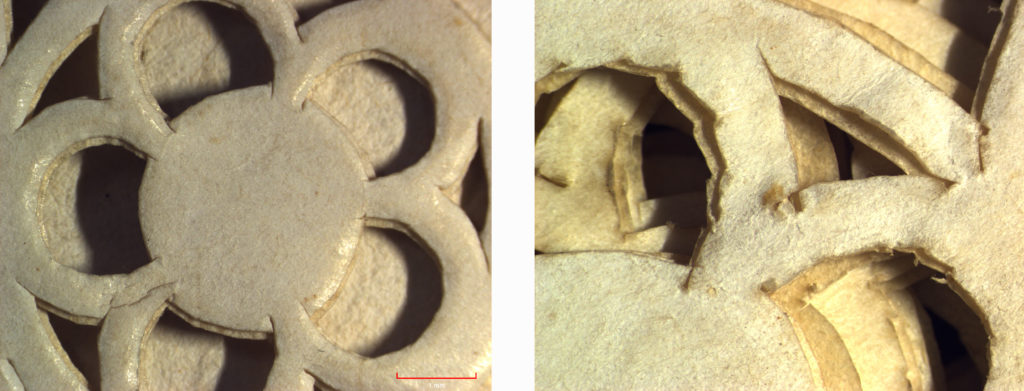
Smooth vs. choppy cuts, photomicrograph details, De Bar Hours, acc. no. W.93, fols. 145r and 84v
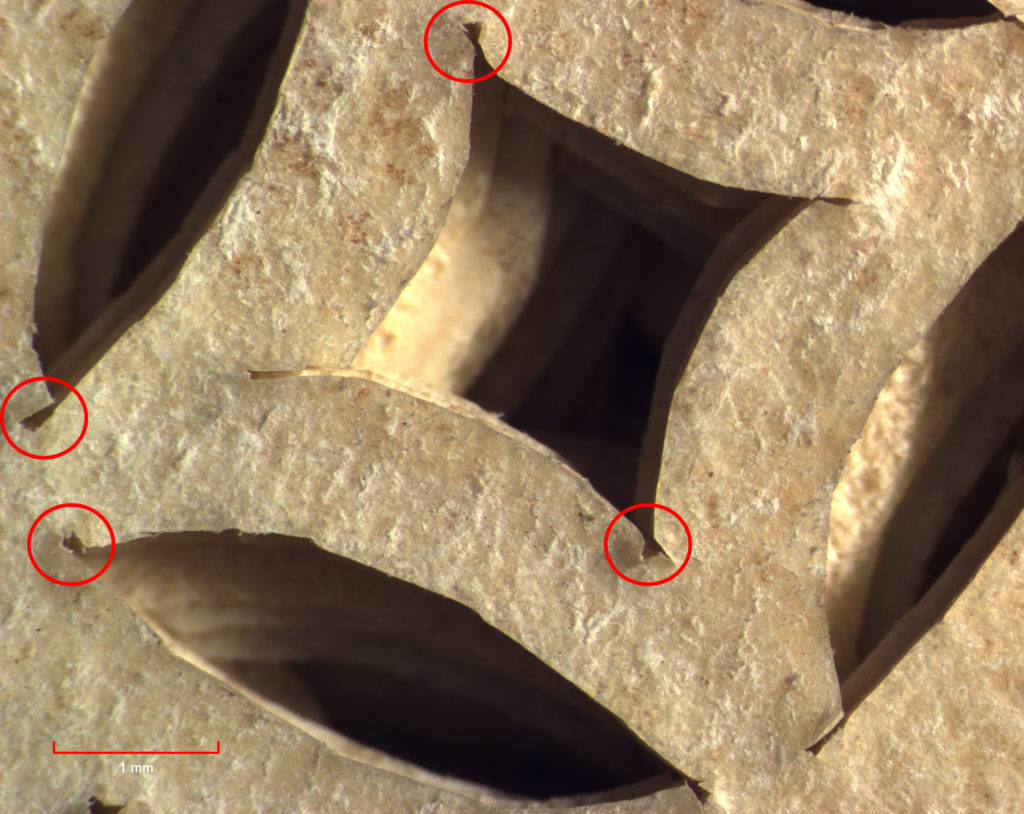
Guide punches, De Bar Hours, acc. no. W.93, fol. 63v
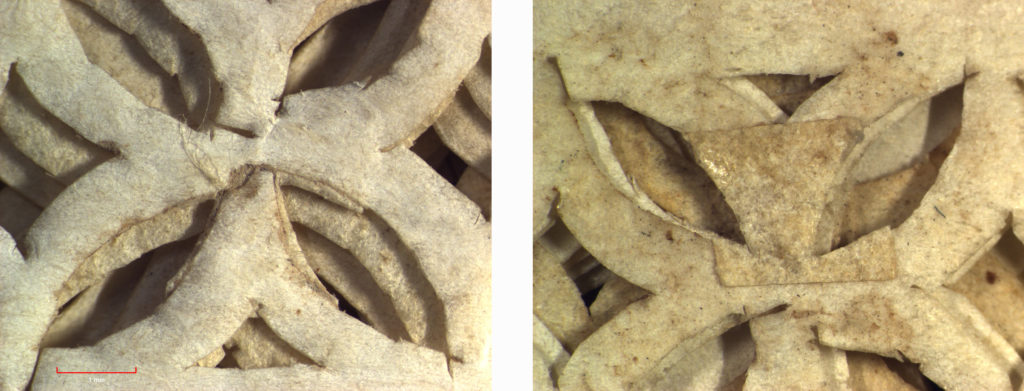
Knife slip on recto and parchment patch on verso, photomicrograph details, De Bar Hours, acc. no. W.93, fol. 19r–v
If, then…
If we can confidently state that the cutting is indeed original to the book’s production circa 1310, then this knowledge raises several fascinating questions that were never really explored before given the previous uncertainty. Although they will take far more time and research to answer, they are worth briefly addressing here.
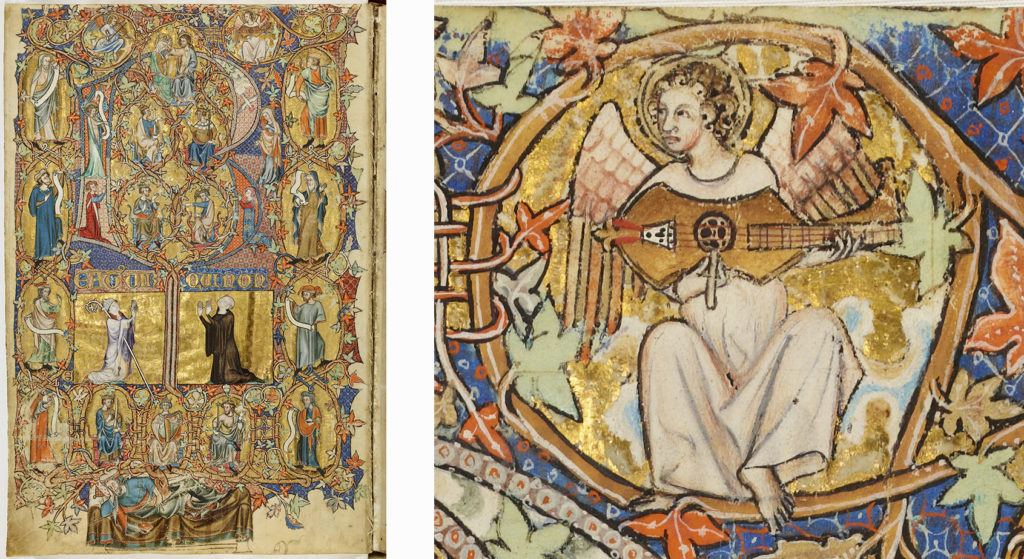
Angel playing citole, Ormesby Psalter, England (East Anglia), ca. 1310, ink and pigment on parchment. The Bodleian Library, Oxford, acc. no. MS Douce 366, fol. 9v
The first question one must ask is who could have made such a thing? Who had the skill and vision to cut such a large amount of parchment, and create this effect for an entire book, if it was not yet being done? As mentioned earlier, ultimately anyone with a knife could have theoretically attempted such a task, whether a scribe with his pen knife, or perhaps a bookbinder skilled at cutting leather. However, the needed expertise might also have fallen outside the skills of bookmakers, so considering a wide variety of professions could be advantageous. While this is an area that will require much fuller research in the future, there are several fascinating possibilities to explore. One group of artisans with the needed skill set is makers of musical instruments. By the thirteenth century in Northern Europe, and even earlier within the Islamic tradition, it was common for stringed instruments such as lutes, citoles, and gitterns to have cut parchment rosettes stretched across the soundbox.[23] Although locating a surviving example from this early period has proved difficult, they are regularly depicted in paintings and illuminations, such as an angel playing a citole in the Ormesby Psalter (fig. 12). This manuscript, which provides a strong visual parallel, dates to circa 1310, and is therefore exactly contemporary with the de Bar Hours. While the Ormesby Psalter is English rather than French, a treatise written by music teacher Johannes Vaillant in Paris in the first half of the fourteenth century also shows this kind of rosette, and musicologist Susan Weiss at the Peabody Institute of the Johns Hopkins University confirmed that such parchment roses had been in use for centuries before the de Bar Hours was produced. I have yet to find any scholarship connecting this craft to the manuscript tradition, and yet surely this cutting of parchment could in some way be related, if only through material. Perhaps this provides a missing link—a contemporary tradition from which the cutting in the de Bar Hours may have emerged.
Shoemakers have also been suggested as another potential group of artisans with the appropriate skill set, as shoes with decorative cutout designs were popular in this period.[24] Could the manuscript’s cut borders have echoed the sartorial fashions of the time? While the individual leaves of the parchment manuscript are more delicate than the more durable leather used for shoes, the pages would have been cut in groups of four, which may perhaps have required someone more accustomed to working with leather. The oddly squared holes Quandt identified as guide punches for the design in the de Bar Hours do resemble the shape made by awls used by shoemakers, so it is possible this may be another fruitful avenue of investigation as research on this manuscript continues in the future.
The second, and perhaps most tantalizing, question remains: who was the intended recipient of such an extraordinary manuscript? There are some internal clues in the manuscript that may make identifying a potential recipient possible. A heraldic emblem in the February calendar, which cleverly doubles as the symbol for Pisces, is easily recognizable as that of the de Bar family (fig. 4).[25] They were one of the most prominent families in the Lorraine region of northeast France, both in the centuries prior to, and after, the moment of this book’s creation. Although a connection to the de Bar family is clear, there has never been a suggestion as to which family member it was made for.
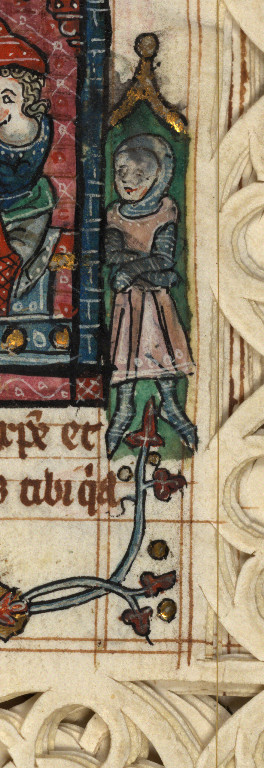
Donor portrait (?) of knight, De Bar Hours, acc. no. W.93, detail fol. 133r
By triangulating the information gleaned from manuscript evidence with the history of the family itself, it may be possible to narrow the pool of eligible recipients. As mentioned earlier, the book has been dated to circa 1310 based on regional style and related manuscript illumination. A large number of saints in the calendar are celebrated in the diocese of Verdun, while the Hours of the Virgin is for the Use of the diocese of Châlons-sur-Marne.[26] Those dioceses border one another in northeast France, which helps localize the area of the book’s intended recipient. Looking at the de Bar family history with this date and location in mind, a possibility emerges: the manuscript may be connected to Edward de Bar I (1296–1336). A knight standing outside of the image frame on folio 133r could very well be, as Randall suggests, a patron portrait (fig. 13).[27] The de Bar family were famed crusaders, and Edward was especially active, going into battle with Frederick IV at the young age of twelve in 1308, and regularly engaging in wars the next three decades, eventually dying in a shipwreck on his way to a crusade in 1336.
Edward was married in 1310 to Marie of Burgundy (1298–1336), and the possibility of a special book to celebrate such an occasion is not out of the question. Both had royal grandparents, descending respectively from Edward I “Longshanks” of England and Louis IX of France. Edward and Marie were formally betrothed in 1306 as children, at the tender ages of ten and eight, and were married four years later.[28] The de Bar family chateau and traditional burial chapel was located in Bar-le-Duc, which falls in the diocese of Verdun, but very near to the Marne region. It is striking that cathedrals and churches in those locations prominently include five petal rosettes. This pattern can be seen in both the windows and the official seal of the twelfth-century cathedral in Verdun, as well as in the stone tracery of two fourteenth-century churches in Bar-le-Duc, one finished five years after Edward and Marie’s marriage and the other built by their grandson Robert (fig. 14). Given the almost sculptural quality of the book’s pages, perhaps it is also the tracery of rose windows, not just lace, that the manuscript’s cut pages are meant to evoke.
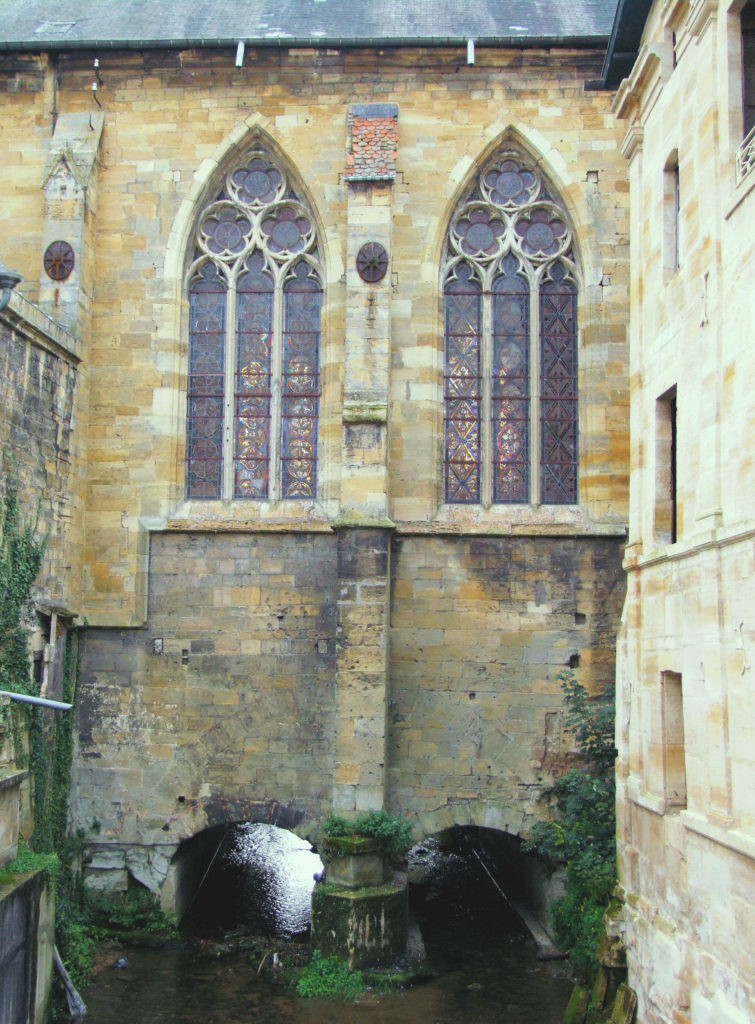
Église Saint-Antoine, France (Bar-le-Duc), 1376, built by Robert de Bar (grandson of Edward and Marie de Bar). Photograph by user MOSSOT / Wikimedia Commons / CC BY 3.0
The union of Edward and Marie in 1310 aligns with both the date of the manuscript and the region suggested by textual clues, while the rosettes in the book echo those they would have regularly encountered when practicing more public devotion. Perhaps the heraldry’s placement in the February calendar could even be read not just as a pun on “Pisces” but as connected to them personally, as the couple was married in that month. Books of Hours were often created to commemorate marriages, and their four-year engagement would have allowed plenty of time to come up with something truly spectacular to celebrate the union of the de Bar and Burgundian families. It has, however, been pointed out that only the de Bar arms is included in the manuscript, so whether or not this fact complicates the possibility of its connection to a marriage is a question to explore further.[29]
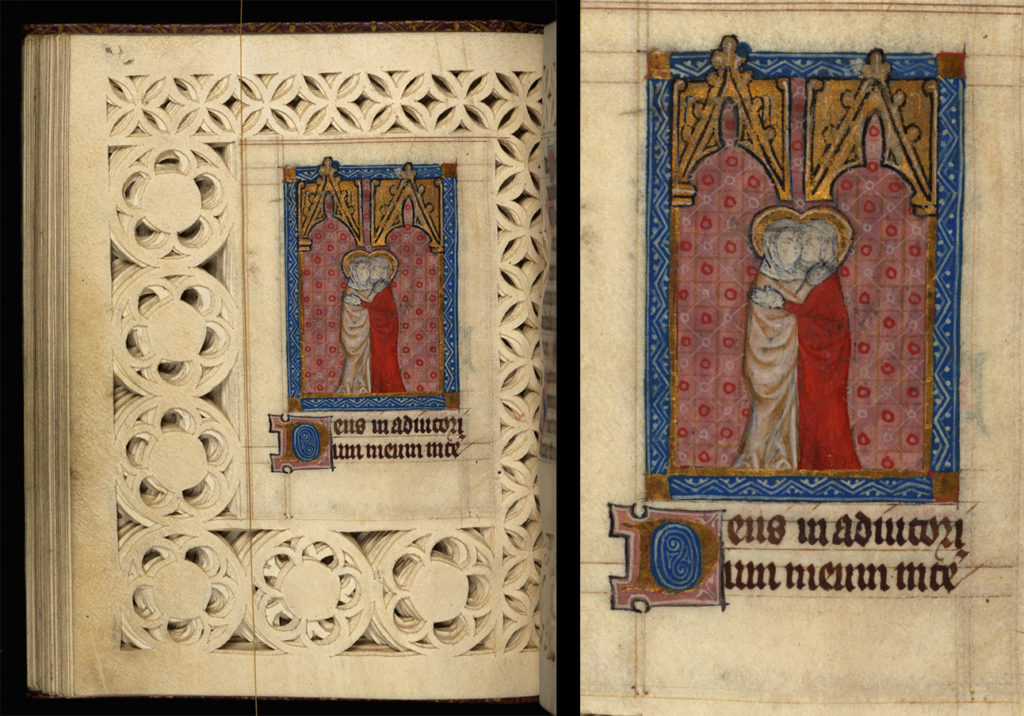
Visitation, with damage from possible devotional touch, De Bar Hours, acc. no. W.93, detail fol. 38v
However, it need not have been produced for that purpose; should this book indeed be connected to Edward de Bar, it could also have been used by, or gifted to, his young bride Marie. Physical traces of touch on two illuminations suggest very personal interactions with select images that resonate in compelling ways with her life.[30] For instance, in the case of the knight and possible patron portrait discussed earlier (fig. 13) there appears to be some localized damage to the figure’s face and the surrounding paint, perhaps due to moisture as it seems to have transferred to the facing page. Such focused damage might suggest kissing or touch, perhaps the act of a wife whose husband was often away at war? The other illumination that displays similarly focused damage is the image of the Visitation, in which the faces of both Mary and Elizabeth are heavily abraded (fig. 15). The lovely cut parchment margin on this page is also fairly heavily grimed, which is not typical of other openings with illuminations in the manuscript, suggesting the act of holding the book open to this spot for a more extended time.[31] The scene is one of two women embracing as they celebrate miraculously becoming pregnant with Christ and John the Baptist, and it is compelling to consider this in the context of Marie’s life. She gave birth to a daughter in her first year of marriage, while practically still a child herself, however it would be seven more years before she would have another child and produce a son and heir. It is easy to imagine a young wife’s desperation for a male child after so many years given that would have been expected of her, and perhaps the worn faces of these holy, pregnant women, along with the soiling on the parchment due to repeated touch, are traces of a poignant human experience we could understand through the lens of Marie’s life. With more research, perhaps such speculation may find further support, or perhaps a wholly different history for the book will be uncovered. Whoever the manuscript’s recipient was, opening its simple boards must have offered a remarkable moment of discovery…of a secret revealed…and the ensuing 700 years has not diminished the thrill of its effect.
In light of the evidence that these unusual lace borders were integral to the manuscript’s design, it is striking to reinsert it into the visual culture of fourteenth-century France and to see how naturally it resonates with gothic architecture, musical instruments, and perhaps even high fashion. This manuscript, both remarkable in its artistic virtuosity and exquisite in its beauty, can now be confidently understood as an incredibly special project from the early fourteenth century, and this knowledge frees us to fully embrace its breathtaking strangeness. We no longer have to set the book aside as a mere curiosity; rather, it deserves to be celebrated as a rare or possibly unique survival from its time, one that points to cross-fertilization between different leatherworking traditions, bold experimentation with the forms we now call Gothic, and the earliest explorations in French canivet.
I would like to give special thanks to my wonderful collaborators on the Walters “Seeing Codicologically” workshop, Benjamin Tilghman and Sonja Drimmer, and to Shirin Fozi-Jones for helping me think through some aspects of this research; to my colleague Abigail Quandt, without whose partnership and shared sense of wonder and curiosity this study would not have been possible; to Lilian Randall for her support, enthusiasm, and perpetual generosity as a scholar; and to my predecessor and mentor Will Noel, who impressed upon me the great value of carving out time to pull manuscripts off the shelves, and to explore them with curiosity and joy.
[1] W.93 has been dubbed the de Bar Hours due to that family’s heraldry, which depicts two fish, appearing in the February calendar on fol. 2v as a clever play on that month’s zodiac symbol, Pisces. The manuscript has been little studied or published. See Seymour De Ricci and W. J. Wilson, Census of Medieval and Renaissance Manuscripts in the United States and Canada, Vol. 1 (New York: H. W. Wilson Company, 1935), 767, cat. no. 61; Judith Oliver, Manuscripts Sacred and Secular from the Collections of the Endowment for Biblical Research and Boston University (Boston: Endowment for Biblical Research, 1985), 56; Roger S. Wieck, Time Sanctified: The Book of Hours in Medieval Art and Life (New York: George Braziller, 1988), 172–73, cat. no. 6; and Lilian M. C. Randall, Medieval and Renaissance Manuscripts in the Walters Art Gallery, Vol. 1. France: 875–1420 (Baltimore: Johns Hopkins University Press, 1989), 149–52, cat. no. 57.
[2] While researching, I uploaded a photo of this manuscript into Google’s image search engine to see if there were other similar things online, and also out of curiosity to see how AI would interpret the image and what it would pull up as most similar in effect. Unsurprisingly, no similar manuscripts emerged beyond much later works that were already known, but it is interesting to note that the image results were overwhelmingly stone and wood carvings, rather than the lace to which the book is so often compared.
[3] 3 Lace Book of Marie de’ Medici (W.494). For more on this and related manuscripts as well as a discussion of cutting like this which is known as canivet, see Isabelle de Conihout, “Bijoux de dévotion. Canivets, reliures et livres de luxe pour Marie de Médicis,” in Henri IV: Art et pouvoir (Tours: Presses universitaires François-Rabelais, 2016), http://books.openedition.org/pufr/8445.
[4] Early notes in the file, including those by the Walters first curator of rare books and manuscripts Dorothy Miner, date it to ca. 1300. Roger Wieck has suggested a general date of early fourteenth century in Wieck, Time Sanctified, 172–73, while Lilian Randall places it into the 1310s based upon artistic style and relationship with other manuscripts of the region related to the family in Randall, Medieval and Renaissance Manuscripts, 151–52. Taking all of this into consideration, I am suggesting a date of ca. 1310.
[5] While it is certainly possible there were other manuscripts with cut borders this early that are now lost, or else that there is another hidden in a collection that remains unpublished and unknown in scholarly circles, none of my colleagues in the field to date have ever seen one from this time period. In conversations with my manuscripts colleagues, including Roger Wieck at the Morgan Library and Museum, and Elizabeth Morrison at the J. Paul Getty Museum, no other early manuscripts like this have come to light. In a number of posts sharing this book on the Walters manuscripts Twitter in May and October of 2019, I inquired if anyone knew of comparable books from ca. 1310, and after thousands of likes, and hundreds of shares and comments, none were offered. Most significantly, Maxence Hermant, curator of Western manuscripts from the 15th–18th century at the Bibliothèque nationale de France (BnF), responded to the thread and confirmed that there is nothing like it at the BnF before the sixteenth century (tweet response, May 21, 2019).
[6] Randall, Medieval and Renaissance Manuscripts, 151–52.
[7] Curatorial notes, various dates, The Walters Art Museum, Baltimore, curatorial files, acc. no. W.93.
[8] There is a pencil notation by Miner on the letter with the Medici manuscript number, W.494, which is curatorial shorthand indicating that the letter relates to that book. It is a testament to her meticulous nature that she also thought to cross-reference the letter’s contents and put a copy in the file for the de Bar Hours. See Letter from Anthony Hobson, 1957, The Walters Art Museum, Baltimore, curatorial files, acc. no. W.93.
[9] One of the great joys of this research project has been having the opportunity to discuss it with Lilian Randall herself. Her generosity as a scholar, and genuine delight at hearing this new perspective, has been truly inspiring.
[10] Randall, Medieval and Renaissance Manuscripts, 151.
[11] I am grateful to my colleague Glenn Gates for taking the time to test this pigment so that the date of this paint can be determined so precisely. A copy of his technical report is preserved in the manuscript’s file; see Technical Report, September, 25, 2019, The Walters Art Museum, Baltimore, curatorial files, acc. no. W.93. The late date of this paint has repercussions for the heraldry on the opening page of the book as well. This heraldry has often been factored into the question of who the manuscript may have been created for, however given that it is painted on top of what we now know to be eighteenth-century paint, it cannot come to bear on any question of early provenance, although it may offer insights about who was believed (or hoped!) to have owned it by the eighteenth century.
[12] See Note from Yael Hoz, 2009, The Walters Art Museum, Baltimore, curatorial files, acc. no. W.93.
[13] Yael Hoz and Ted Gorelick, World Papercuts: Tradition, Art, Craft. (Haifa: Haifa Museum of Music & Ethnology, 1986).
[14] There are a number of Coptic bindings with cut designs in the leather at the Morgan Library and Museum. See for example the Morgan’s acc. no. MS M.584A1, dating from the ninth-tenth century, which has designs cut out and colored parchment showing through.
[15] Hoz and Gorelick, World Papercuts, 99.
[16] There is an excellent depiction of one of these pen knives in the Walters own eleventh-century Reichenau Gospels, acc. no. W.7, fol. 67v, where the Evangelist Mark sits poised to write with a pen in his right hand, and a pen knife in his left.
[17] In addition to my own lack of results when searching for comparables, Hoz and Gorelick, World Papercuts, 71–86, discuss the tradition within the context of England, the Netherlands, France, Switzerland, Germany, and in the Jewish faith more broadly, and the earliest examples cited all date to at least the seventeenth century.
[18] Note that the book appears to have been trimmed, as is typical, when it was rebound in the eighteenth century, therefore the margins would likely have been a bit wider still when the book was originally produced.
[19] Yael Hoz suggested in her notes that the pages were most likely “cut in groups of 2–5, which is common practice…” Looking at the leaves within their quire structure helped determine that this is indeed the case, and that they were cut four at a time within each self-contained quire.
[20] Randall, Medieval and Renaissance Manuscripts, 150.
[21] A contemporary French Book of Hours in the Walters collection, acc. no. W.104, is a delightful example of how marginalia usually behaves in this period.
[22] I would like to thank Aubrey Vinson, who interned with me in the Walters rare book library in 2016 and helped think through the strange behavior of the marginalia, and the possibility that it may be a clue as to the dating of the cut margins.
[23] I am grateful to Susan Weiss for her assistance in thinking this through, and for her helpful suggestions for articles on medieval instruments. See Christopher Page, “Fourteenth-Century Instruments and Tunings: A Treatise by Jean Vaillant? (Berkeley, MS 744),”The Galpin Society Journal 33 (1980): 17–35; Jeremy Montagu, “Musical instruments in Hans Memling’s paintings, Early Music 35, no. 4 (November 2007): 505–24; José María Salvador González and Candela Perpiñá García, “Exaltata Super Choros Angelorum: Musical Elements in the Iconography of the Coronation of the Virgin in the Italian Trecento Painting,” Music in Art 39, no. 1–2 (2014): 61–86; and Angela Bellia, “Twelfth-Century Musical Symbols in the Star-Studded Sky of King Ruggero II,” Music in Art 37, no. 1/2 (2012): 24–34.
[24] This fascinating suggestion was made by a number of attendees at the end of a virtual talk, “New Eyes on Old Books: Unraveling the Mystery of the Walters Lace Manuscript,” that Abigail Quandt and I gave for Walters Art Museum members in February 2021. I am especially thankful to attendee Arnie Sanders, who has suggested a rich variety of avenues for future research on both potential craftspeople such as cobblers, as well as ways to investigate my theories about the book’s patronage.
[25] An old note in the manuscript’s file queries whether the heraldry may have been added to the calendar early on. While the illumination style and paint appear consistent, and it does not appear to be overpainted, this needs to be checked to be certain of its originality.
[26] Randall, Medieval and Renaissance Manuscripts, 149.
[27] Randall, Medieval and Renaissance Manuscripts, 151.
[28] A helpful compilation of genealogical information on this family, which includes specifics about Edward and Marie’s engagement and marriage, can be found on the Foundation for Medieval Genealogy site.
[29] I would like to thank Roger Wieck, Beth Morrison, and Arnie Sanders, Emeritus Associate Professor of English, and Bibliographic Description Volunteer at Goucher Library Special Collections, for their insights and thoughtful questions about this aspect. This is a tradition I will need to explore more deeply to see if both families’ heraldry must always be present.
[30] It is of course impossible to know at what point in a manuscript’s history such devotional damage occurred. However it is interesting that in this case, the particular instances of touch align with the biographical details of one potential owner, so I offer this as one possible reading of the physical evidence in the book.
[31] This fascinating observation was made by Quandt.
